You see them in your neighborhood, at the nursery, and at local home improvement stores and wonder if hydrangeas will suit your garden and your experience level. The big, beautiful leaves, with the mounds of pillowy flowers, are appealing to many home gardeners.
They come in different shapes, can climb, be bushy, or grow like small trees, and have a variety of flower colors. The flowers range from red, pink, blue, purple, green, and white, so they will match nearly any color palette.
Hydrangeas are relatively easy to grow as long as you meet a few of their requirements. Keep reading as we go over step by step instructions on how to keep your hydrangeas blooming year after year.
Table of Contents
What Are Hydrangeas And Where Do They Come From?
Most hydrangeas are considered a shrub, but there are some that can grow like small trees. The large majority of these plants you’ll find at your local plant retailer are shrubs.
They are perennial plants that will come back year after year in Zones 3 through 9. They produce large, cotton candy like flower clusters from spring into summer, and sometimes into fall.
These slightly herbaceous bushes can grow upwards of 10 to 15 feet tall, are swift growing, and can be large centerpieces in your garden. The flowers can be cut and kept in bouquets for a long time, and nearly indefinitely if they are dried and kept.
Hydrangeas get their name from the Greek words “Hydro” and “Angeion,” which mean water and vessel respectively. The name is derived from the pitcher like flowers, and because the plant is a water loving shrub.
Hydrangeas are native to Asian countries such as Korea and Japan, and some were even found in North and South America dating back to nearly 60 million years ago. The North American hydrangeas were brought to England by American colonists in the 1730s.
Hydrangea Fast Facts
- Botanical Name: Hydrangea Hydrangeaceae
- Average Height: Between 10 to 15 feet, up to 20+
- Average Spread: 4 to 10 feet
- Water Preference: Moist soil, not very drought tolerant
- Soil Preference: Slightly acidic (pH 5.5 to 6.5) well draining, loamy soil
- Sun Preference: Partial sun. Morning sun preferred. 6 to 8 hours
- Hardiness Zones: 3 to 9
- When to Plant: Spring or fall
Varieties Of Hydrangeas
There are dozens of hydrangeas and cultivars, but we’ll go over the most common varieties. Usually, you will see bigleaf or oakleaf hydrangeas, but you may also come across panicle hydrangeas or smooth hydrangeas as well as a few more.
Bigleaf Hydrangeas
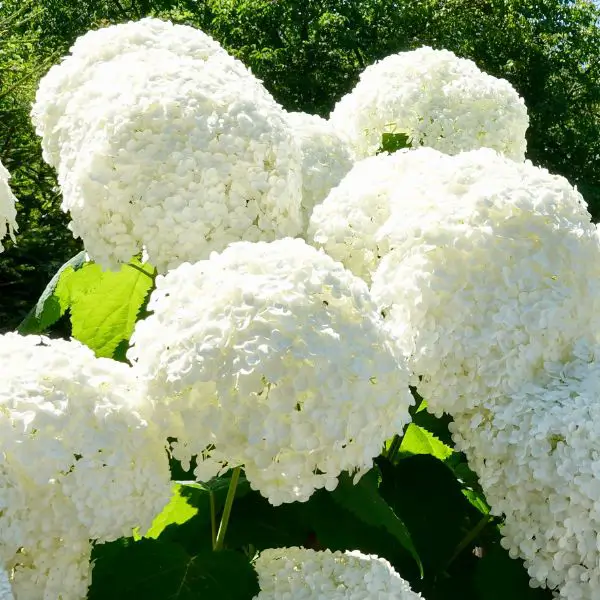
The most common and popular hydrangea often are grown in Zones 5 through 9. These bushes have large, broad leaves, and big, round flower heads that bloom from spring into summer. Depending on the temperature, cooler areas may see these flowers lasting into early fall.
The bigleaf variety is also known by the names hortensia, lacecap, mop-head, or French hydrangea. They are also called snowball plants, but that’s the name my family gave to any variety of hydrangea when I was younger.
Oakleaf Hydrangeas
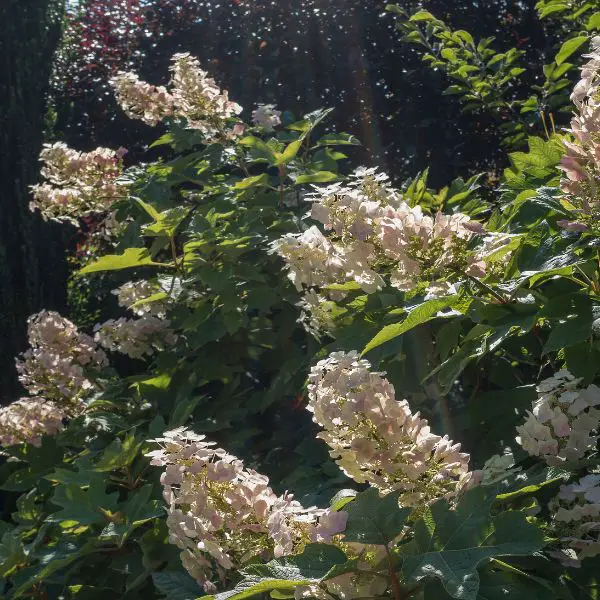
Hydrangeas can usually handle moderately hot summers, but the oakleaf variety is the most heat tolerant of them all. Like oak trees, the oakleaf hydrangea has lobes leaves that also turn red and bronze in fall.
They produce flower spikes or panicles instead of the puffy, round “snowballs.” This variety comes from the southeast U.S. and can handle the hot dry summers better than other hydrangea cultivars.
Smooth Hydrangea
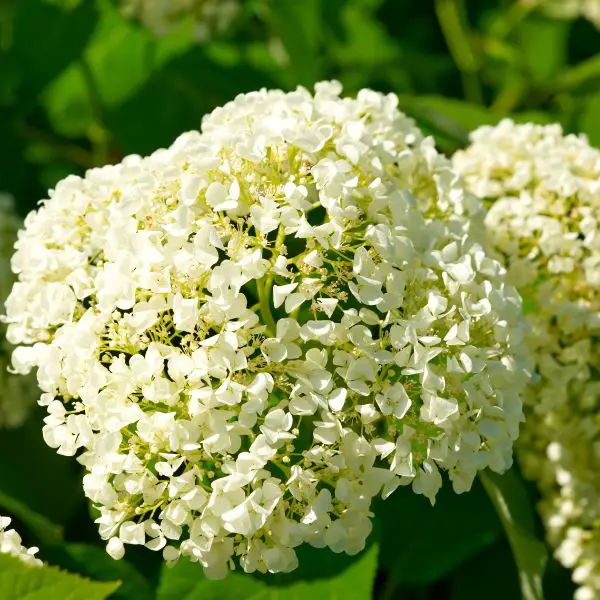
These plants have large, oval shaped leaves and are one of the few varieties that produce fertile flowers. Most hydrangeas grow flower clusters that are only for show and produce little to no seeds at all.
The smooth hydrangea is often called a “wild hydrangea.” Their flowers begin green and gradually shift from off white to plain white, but increasing the acidity of the soil will not affect the color. This variety is especially suited for colder climates.
Panicle Hydrangea

Be careful growing these varieties of hydrangeas because the panicle, or PeeGee (PG) can grow into a small tree that reaches heights of around 25 feet! While they get very tall, they are easy to grow and hardy up to Zone 3.
Panicle hydrangeas often change color in the fall. The leaves transform into brilliant shades of orange and red, while the white flowers may warm up to different shades of pink and even, rarely, red.
Climbing Hydrangeas
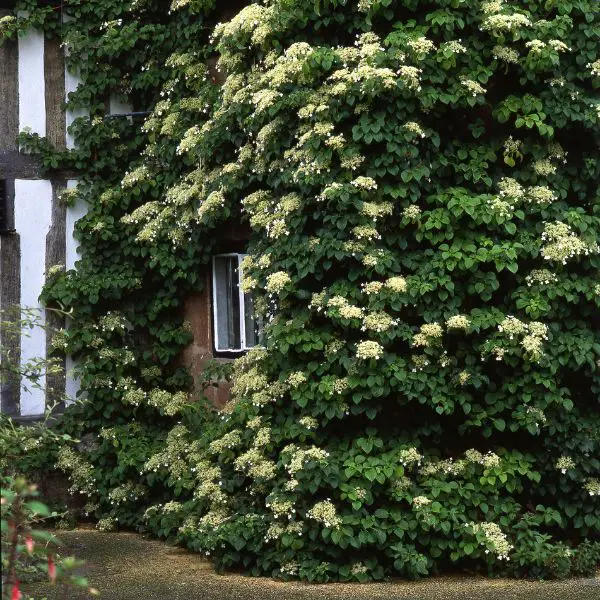
As the name suggests, these varieties can climb on supports up to 30 feet or higher. They can also be trimmed down to remain decently shrub sized.
Climbing hydrangeas grow heart shaped leaves and produce fragrant flowers, so if you like a little whiff of perfume in the summer, consider this plant.
These flowers produce seed pods and grow aerial roots that help the plant climb up strong supports.
Blue Hydrangeas
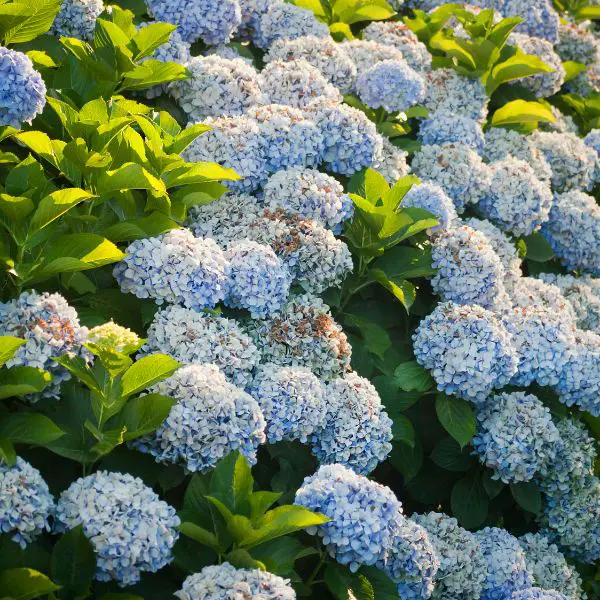
These are the notorious color changing hydrangeas. Hailing from the bigleaf family, blue hydrangeas keep their color because of soil acidity. You may plant them one year for their brilliant blue, only to find them turning a warm pink the next year.
You’ll have to keep the soil more acidic to make sure they stay blue year after year. When the soil turns more alkaline, you will end up with pink flowers, or a mixture of blue and pink.
You can’t change the color of other hydrangeas by altering the pH. Purple, white, green, and most pink varieties will keep their color regardless of soil acidity.
When, Where, And How To Plant Hydrangeas
While these beauties are easy to grow and don’t require much maintenance, you have to get a few things right or you could run into problems later on. Here we’ll let you know all about planting hydrangeas for success.
Waiting On The Sun
Before plopping your hydrangea in the soil, find out how the sun hits various areas. Hydrangeas typically prefer morning sun and afternoon shade. During the long, hot summer, if your hydrangea is in indirect, late day sun, it will wilt, and probably suffer.
Most varieties require 6 to 8 hours of sun, and they prefer it to be gentle, morning sunlight. Look for a place that receives unfiltered morning sunlight, and then is either shaded, or gets filtered afternoon sunlight from a larger tree, or on one side of your house.
Have You Ever Seen The Rain
Being that their name is basically “water vessel,” you can bet that these plants like plenty of water. While constantly wet roots will ultimately lead to root rot, hydrangeas do like to be consistently watered.
Typically they grow best when they get about an inch to two inches of water per week. They may need more during hot, dry summers, especially in Zones 7, 8, and 9.
When watering your hydrangeas, just soak the soil, don’t spray the plant and the leaves, as this can cause mold, fungus, or even sun scorch. A good Soaker and irrigation hose works best for watering.
Obviously, if you are getting ample rainfall, and your plants are looking vibrant and healthy, you won’t need to water them. But when the soil feels dry an inch or two down, it’s time to give your shrubs a good, long drink.
Newly planted hydrangeas will need more water until they have become established. For the first week or two you may have to water them every other day, especially if it’s hot and dry out.
Just check the soil every day. You want the ground to be damp, not soggy, and not dusty. If it’s dry, add some water, if you feel moisture, wait a day or two.
Dirt On My Boots
The right soil is also essential for a healthy growing hydrangea. These plants love a rich, well draining soil that retains some moisture but won’t leave the roots swimming in water.
While some varieties can handle the southern red clay, it’s best to loosen up heavy dirt or add moisture retention to sandy yards. A rich loamy soil is best for these plants, but who naturally has that kind of gardener’s delight in their yards?
If you have a heavy clay soil like me, adding rich, well matured compost is a great way to loosen it up. Claybreaker can also help, but you’ll still need some nutrients.
For loose, sandy soils, add some gardening soil, compost, or Water Storing Crystals to help more moisture stick around longer. A good, three to four inch bed of mulch is another way to keep the ground moist longer.
Best Times To Plant
For most plants, spring and fall are the best times to put your hydrangeas in the ground. In early spring, the plant has time to stretch out its roots, produce plenty of leaves, and start storing food for the coming winter.
Even in fall, the plant is able to grow some deep, strong roots that will help it survive the cold, dormant winter weather. During fall, the plants really focus on root growth and do not focus on growing leaves and flowers. This will help it to do even better the following year.
What About Feeding Hydrangeas?
Hydrangeas are not heavy feeders, and if you add compost once a year, you most likely won’t have to do any supplemental fertilizing.
That being said, a little bit of plant food, especially slow release plant food such as Osmocote Smart-Release Plant Food Plus won’t hurt if you follow the manufacturer’s instructions and only fertilize in late winter/early spring or early fall.
If you can manage it and want to add some plant food to your hydrangeas, the best time is later winter a few weeks before the last frost is estimated. This will help to provide nutrients as the plant begins to break dormancy.
You don’t want to feed in late fall or winter as it could cause the plant to start growing when it should be dormant. The new growth will just end up getting damaged when the next frost or hard freeze hits.
Pruning Versus Deadheading
Should you prune your hydrangeas? Do they need to be cut back to the ground? What exactly is deadheading and what are the benefits?
Some hydrangea varieties don’t need any pruning aside from removing old, dead wood. Others produce flowers on old wood and need a light pruning in the summer after they are finished blooming.
Inspect your hydrangea and see what type it is. Hydrangeas that grow like shrubs and produce herbaceous stalks can benefit from deadwood removal. These you don’t need to prune much, aside from keeping the shape you want.
For hydrangeas that grow woody climbing vines, or grow like a tree, trim off up to one third of the old wood branches to keep it tidy and blooming. Make sure you trim them in the summer and not in the spring or you might trim off new blooms.
Some hydrangeas can be cut back to the ground in late winter or early spring before new growth appears. For these plants, the stems will be dried out completely, and hollow. They will often pull straight up from the ground, but avoid doing this as it can harm new growth.
Just cut the dried, dead branches back close to the ground to keep these bushes clean and growing healthy.
Deadheading refers to removing spent flowers. Some gardeners prefer to cut hydrangea flowers and keep them inside, while others let them bloom on the bush. Whatever your preference, this won’t harm your plant.
If you want more blooms on your hydrangeas, up until fall, deadhead them. Whenever the flowers start fading and drying out, snip them off. The plant will conserve energy this way, and start producing more flowers.
Propagating Hydrangeas
There are three methods for propagating hydrangeas. While you can grow them from seeds, it’s the most difficult way, and most hydrangea flowers don’t even produce any seeds, so we won’t discuss that method.
The methods we’ll go over include water propagation, soil propagation, and ground rooting.
Water Propagation
This method is the easiest, but may net mixed results. Some work, some will not. All you need to do is start in early spring when the plants are starting to grow and snip off a short piece of branch that has a few nodes.
The nodes are where the leaves sprout from the branch. These will produce the roots.
Find a new growth branch that has at least 6 inches of new, soft, green growth and snip it off with clean, sharp shears. Trim off all but the top two to three leaf sets. You don’t want big leaves as they will dry out quickly.
Now, place the stem in water and hope for roots. Change out the water every few days so it doesn’t get slimy and nasty. In a few weeks, you should see roots. When they are about 3 or 4 inches long, carefully plant them in soft soil, preferably a seed starter, and keep them moist for two weeks.
Soil Propagation
This method tends to get more results and produces stronger roots. Follow the first few steps as mentioned above, but instead of placing the trimmed stem in water, you’ll want to dip the node in a rooting hormone.
Next, stick your finger into a small pot filled with seed starter to make a hole for the stem. Gently place the stem into the dirt, this helps to keep the rooting hormone on the plant, and carefully fill in the open space.
Keep the soil moist for 3 to 4 weeks as the roots begin to grow. You can place a small, clear plastic bag over the top of the plant to help keep moisture in, though this isn’t necessary. It just helps to keep the soil damp.
Ground Rooting Propagation
For hydrangeas that have stems near the ground, this method may be the most successful.
Find a branch or two that are either already laying on the ground, or can be bent down without snapping them.
Clear away any mulch, or leaves so the soil is exposed and place a part of the stem on the ground. You can dig out a tiny divot and cover part to the stem as well.
Next, use a brick, or rock to hold the stem in place. Trim off any leaves that are touching the ground and continue to water the plant as you normally do.
After a week or two, check to see if there are any roots. When you see roots. Trim the branch away from the mother tree, but leave it in the ground for another week or two.
Let the roots get a little bit more established, then you can dig the new plant up and plant it wherever you want another hydrangea bush to grow.
Will Hydrangeas Grow In Pots?
If you live in an area that isn’t conducive to hydrangea growing, you can definitely keep them in pots. They grow very well in containers and can be moved out when it’s warm or moved inside when Jack Frost comes in with his freezing temperatures.
Since these plants love water, you’ll need to water them more frequently while they are in containers. To help, place them in non-porous containers, but make sure there are ample drainage holes.
The pots need to be big enough to house them comfortably, so look for diameters of 18 inches or larger. You can also look for dwarf varieties to help contain the space, and so you’re not trying to lug around a pot that weighs roughly equivalent to a small car.
Frequently Asked Questions
Should I winterize my hydrangeas?
Hydrangeas are perennial plants that will come back every year in Zones 3 through 9. Usually, you won’t have to do anything to winterize them aside from protecting them from early or late frosts. Cover them with burlap, or other breathable fabric when new growth shows up, but you get an unexpected frost.
If you want, you can help protect the roots and new stems by mounding shredded leaves, or light mulch up to 12 inches high around the base of the plant. When spring rolls around, remove some of the mulch, down to 3 to 4 inches.
Do hydrangeas grow well in the shade?
Hydrangeas like some shade. Preferably in the afternoon and early evening. Most hydrangeas still need between 6 to 8 hours of sunlight to bloom. If they are in the shade too long, they will not bloom.
When will hydrangeas bloom?
Depending on the variety, most hydrangeas will bloom from spring to fall. In very hot climates, these plants will typically slow down or stop blooming in summer, and resume in fall.
Can I change the color of the hydrangea’s flowers?
Bigleaf hydrangeas are the only ones that will change their flower color depending on the pH of the soil. The blue varieties can change to pink if your ground is more alkaline. You can lower the pH and keep blue flowers by adding sulfur or other acidic supplements to the soil. The plants also need aluminum sulfate in the ground to produce blue flowers.
For bright pink flowers, add lime to raise the pH, but be sure you don’t go above 7.5. Anything higher than that can cause damage to the plant. Use a soil pH tester to measure the acidity or alkalinity.
That’s A Wrap
As long as you plant hydrangeas in a somewhat shady spot that gets early morning sun, give them plenty of water, and amend the soil if needed, hydrangeas will grow well with very little issue.
There are several varieties to choose from. You can grow mounding bushes that put on a beautiful show all through the growing season, find climbing hydrangeas to shape how you want or get tree-like varieties that can get rather tall.
These plants can be found around the world, or in your garden with a little bit of care. Hydrangeas are hardy, showy, fun to grow, and can become a focal point in any gardenscape. Pick out a few favorites, and get growing!
More Hydrangea guides
